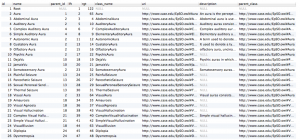Epilepsy and Seizure Ontology (EpSO)
The Epilepsy and Seizure Ontology (EpSO) is a notable effort in creating a formal knowledge model corresponding to the 2010 ILAE epilepsy classification system through close collaboration between epileptologists, clinicians, members of the ILAE CTC, and computer scientists.
Web Ontology Language (OWL2) recommended by the World Wide WebConsortium (W3C) is used to present the concepts and relations [10].
OWL2 is a formal knowledge representation language based on description logic that supports automated reasoning and can be used in web-based applications
EpSO is the key knowledge resource for OPIC, driving many of its functionalities, including structured menu-driven data entry and data harmonization through use of uniform terminology across the participating study centers.
Ontology-Driven Data Modeling
Ontology concepts are mapped to the database with its original hierarchy preserved
There are nine principal data fields being mapped from EpSO to the MySQL-based database:
- Id: a unique number assigned by the database to identify the data record in the database.
- Name: the actual named displayed in the drop-down menus in the OPIC.
- Parent_id, lft, and rgt: these three fields are generated by a useful gem named awesome_nested_set, which helps to maintain the structured architecture for the values in the drop-down menu.
- Uri: the unique resource identifier for each concepts from EpSO.
- Description: records the synonyms of the corresponding concept.
- Parent_class: uri of the parent class of the corresponding concept.
Template Creation
Clinicians can annotate discharge summary reports processed by EpiDEA according to the cohort identification template
